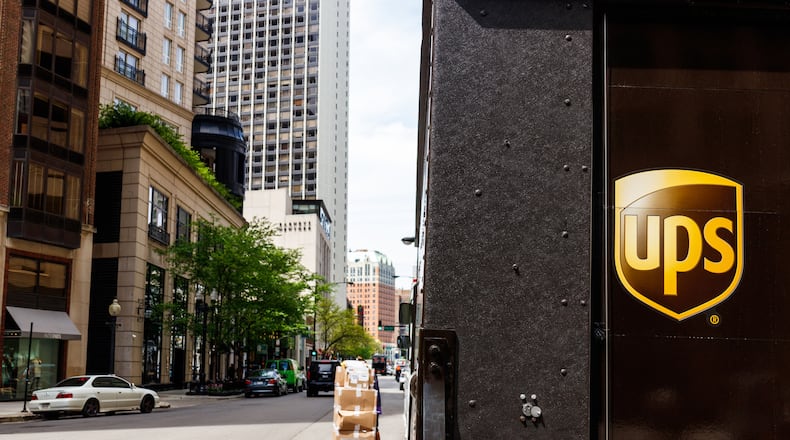Revenue and profit soared in the second quarter at UPS, but the shipping giant delivered fewer packages as pandemic buying habits shifted, sending its stock price sharply lower.
Home deliveries declined from a year earlier as more Americans ventured out, even as the company more than made up for that by steering customers to pricier options and charging more for shipments overall.
“Many of our brick-and-mortar enterprise customers reopened their stores, and as the economies reopened, customers went back to those stores,” Chief Executive Officer Carol Tomé said during an investor conference call Tuesday.
The Sandy Springs-based company handled 0.8% fewer packages than it did in the same quarter a year ago, but brought in 15% more revenue per package. It carried more pricey next-day air and international packages and fewer of the less-expensive deferred and ground packages.
U.S. domestic next-day air revenue per piece was $18.53 in the quarter, up from $16.62 a year ago. U.S. domestic ground package revenue per piece was $9.86, up from $8.71 a year ago.
Analysts said domestic results fell short of their expectations, with the company’s quarterly U.S. domestic package volume declining 2.9% from a year earlier.
The company’s share price was 7.1% lower at $194.98 in afternoon trade Tuesday on the New York Stock Exchange.
UPS said its net income soared 51% in the three months ended June 30 to $2.68 billion from $1.77 billion a year earlier. Revenue totaled $23.42 billion, up 15% from the same quarter of 2020.
Tomé emphasized the company’s “better not bigger” strategy, prioritizing higher-margin business rather than pure expansion. “We believe our strategy is working,” she said Tuesday.
Excluding SurePost packages, which are lower-cost shipments that UPS can hand off to the U.S. Postal Service for final delivery, domestic ground package volume was up, according to Chief Financial Officer Brian Newman.
UPS said it expects an operating margin of 12.7% for the full year, up from 9.2% in 2020. But Newman also acknowledged “there’s a lot of uncertainty out there with COVID and the Delta variant.”
The company is preparing for the busy holiday shipping season and the rapid ramp up in hiring amid a tight labor market. At the height of the holidays demand is expected to exceed capacity by about 5 million packages per day, according to Tomé. That’s down from a 7 million a day shortfall last year, which drove lengthy delivery delays and complaints.
“We’re adding capacity,” and so are competitors, Tomé said.
She said UPS is lining up aircraft leases and rental equipment it will need to manage the volume. To compete for labor, Tomé has focused on improving employee sentiment, so that more workers recommend joining the company.
UPS in the quarter also paid a bonus to the 38,000 part-time management employees working in its hubs and sorting facilities, a $20 million expense, and increasing wages as laid out in labor contracts. The company has more than 540,000 employees overall.
Second-quarter operating expenses of $20.17 billion were up 11% from a year earlier.
But the sale of its low-margin freight unit, which closed April 30, lowered its pension and post-retirement liabilities by $2.1 billion.
About the Author
The Latest
Featured



